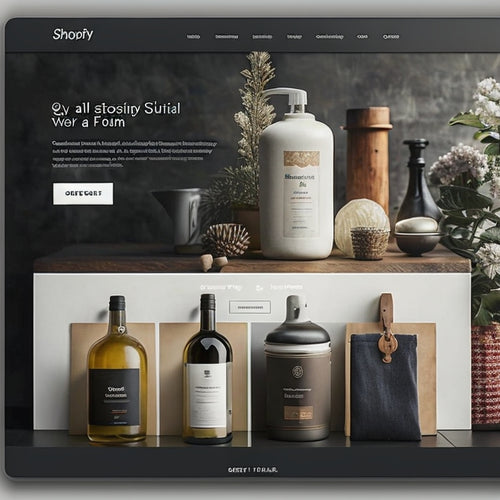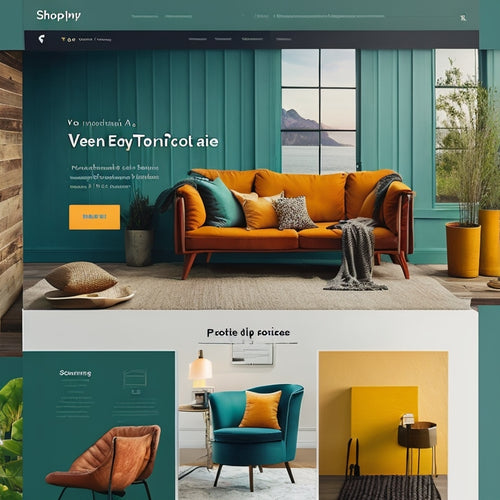
10 Digital Strategies to Fuel Online Sales Growth
Share
To fuel online sales growth, you'll want to implement a mix of digital strategies that drive conversions. Start by leveraging social media influencers who align with your brand values, and optimize your product pages with high-quality images and customer reviews. Next, implement retargeting ads that focus on high-value users, and enhance your email marketing automation with personalized content and timely promotions. Additionally, invest in SEO strategies like keyword research and mobile optimization, and streamline your checkout process with guest checkout and real-time validation. By combining these strategies, you'll be well on your way to boosting online sales - and there's even more to explore beyond these initial steps.
Key Takeaways
• Partner with social media influencers who share brand values to increase brand awareness and drive sales growth.
• Optimize product pages with high-quality images, customer reviews, and key product features to shape the buyer's journey.
• Implement retargeting ads that focus on high-value users who have abandoned carts to drive conversions.
• Enhance email marketing automation by personalizing content and triggering timely promotions based on customer behaviors.
• Leverage user-generated content, such as customer reviews and influencer collaborations, to build trust and drive sales.
Leverage Social Media Influencers
By partnering with social media influencers who've already built trust with your target audience, you can tap into their follower base and increase brand awareness, ultimately driving online sales growth.
Influencer collaborations are a powerful way to reach new customers, with 70% of millennials trusting influencer opinions over traditional celebrities. To maximize the impact of these partnerships, focus on engagement strategies that drive authenticity. This means working with influencers who genuinely believe in your brand and products, rather than just paying for promotions.
Look for influencers with high engagement rates, such as likes, comments, and shares, as this indicates a loyal and active follower base. Additionally, prioritize influencer partnerships that align with your brand values and messaging, ensuring a cohesive and trustworthy image.
Optimize Product Page Experience
On your product pages, every element - from product images to customer reviews - plays a critical role in shaping the buyer's journey, and optimizing this experience can boost conversions by as much as 25%.
To maximize this impact, focus on visual storytelling through high-quality product images that showcase your product from multiple angles. This will help customers better understand your product and increase the likelihood of a sale.
Additionally, make sure customer reviews are prominently displayed, as 85% of customers trust online reviews as much as personal recommendations. You can also use reviews to highlight key product features and benefits, further enhancing the buying experience.
Implement Retargeting Ads
When implementing retargeting ads, you'll want to focus on the users who matter most - those high-value users who are likely to convert.
By optimizing your ad creative, you'll increase the chances of re-engaging these users and driving conversions.
To maximize your ROI, it's essential to continually refine your ad strategy to achieve the highest possible conversion rates.
Target High-Value Users
You can greatly enhance online sales by targeting high-value users who've previously interacted with your brand, as they're more likely to convert into repeat customers. By focusing on these high-value users, you can increase customer loyalty and retention, ultimately driving more sales.
To target high-value users effectively, consider the following strategies:
-
Segment your customers: Identify and separate high-value users from the rest of your customer base to tailor your messaging and offers.
-
Develop loyalty programs: Reward high-value users for their repeat business, encouraging them to continue purchasing from your brand.
-
Implement targeted messaging: Craft personalized messages and offers that resonate with high-value users, increasing the likelihood of conversion.
-
Analyze user behavior: Study the behavior of high-value users to understand what drives their purchasing decisions and optimize your marketing strategies accordingly.
-
Retarget with precision: Use retargeting ads to reach high-value users who've abandoned their shopping carts or haven't converted in a while, nudging them to complete their purchase.
Optimize Ad Creative
By crafting compelling ad creative that resonates with high-value users, you can significantly boost the effectiveness of your retargeting ads, ultimately driving conversions and revenue.
To achieve this, focus on visual storytelling that captures users' attention and creates an emotional connection. Use high-quality images or videos that showcase your product's benefits, and guarantee your messaging is concise and clear.
A/B testing can help you identify the most effective creative elements, such as imagery, headlines, and calls-to-action. Analyze user behavior and adjust your ad creative accordingly.
For instance, if users are abandoning their carts, create ads that address their pain points and offer incentives to complete the purchase. By tailoring your ad creative to your target audience, you can increase engagement, build brand loyalty, and drive sales.
Maximize Conversion Rates
How can you tap into the 72% of shoppers who abandon their carts, and turn them into paying customers? One effective strategy is to implement retargeting ads, which target users who've interacted with your brand but haven't converted yet. This approach allows you to re-engage potential customers and encourage them to complete their purchase.
To maximize conversion rates, consider the following strategies:
-
Segment your customers: Divide your audience into distinct groups based on their behavior, demographics, and preferences. This helps you tailor your messaging and improve user experience.
-
Optimize your call to action: Use A/B testing to identify the most effective CTAs that drive conversions.
-
Streamline your checkout process: Make it easy and seamless for customers to complete their purchase.
-
Personalize your messaging: Use customer data to create targeted ads that resonate with your audience.
-
Continuously test and refine: Monitor your results, identify areas for improvement, and adjust your strategy accordingly.
Enhance Email Marketing Automation
As you focus on enhancing email marketing automation, you'll want to prioritize strategies that drive conversions and foster deeper connections with your audience.
By automating timely promotions, you can capitalize on key moments in the customer journey, such as abandoned carts or birthdays, to re-engage customers and boost sales.
Meanwhile, personalizing email content based on individual behaviors and preferences will help you build trust and loyalty with your customers.
Trigger Timely Promotions
You can greatly enhance conversions by using email marketing automation to trigger timely promotions that reach customers at critical points in their buying journey. By doing so, you can create a sense of urgency, encouraging customers to make a purchase.
For instance, you can set up automated email campaigns that offer limited-time discounts or flash sales to first-time buyers, cart abandoners, or repeat customers.
Here are some ways to trigger timely promotions:
-
Welcome offers: Send new subscribers a discount code or free shipping on their first purchase within a specific timeframe.
-
Abandoned cart reminders: Trigger an automated email with a limited-time offer to customers who left items in their cart.
-
Birthday rewards: Send customers a special offer or discount on their birthday to encourage a purchase.
-
Win-back campaigns: Target inactive customers with a personalized offer to re-engage them with your brand.
-
Price drop alerts: Notify customers when the price of an item they've shown interest in has dropped, creating a sense of urgency to buy.
Personalize Email Content
By tailoring email content to individual customer preferences and behaviors, you can boost engagement, drive conversions, and foster loyalty, ultimately maximizing the impact of your email marketing automation efforts.
To achieve this, you need to leverage data and analytics to create targeted segmentation. This involves dividing your email list into distinct groups based on demographics, purchase history, and browsing behavior.
Once you've segmented your audience, you can create personalized recommendations that resonate with each group. For instance, if a customer has abandoned their cart, you can send a follow-up email with personalized product suggestions based on their browsing history. This strategy not only increases the likelihood of conversion but also enhances the overall customer experience.
Invest in Search Engine Optimization
Since 75% of online users never scroll beyond the initial page of search engine results, optimizing your website for search engines is crucial to enhancing your online visibility and driving sales. By investing in search engine optimization (SEO), you'll enhance your website's ranking, attract more traffic, and ultimately increase conversions.
Here are some key strategies to focus on:
-
Conduct keyword research: Identify pertinent keywords and phrases your target audience is searching for, and integrate them into your website's content.
-
Optimize for local SEO: If you have a physical store or cater to a specific geographic area, implement local SEO strategies to draw in local customers.
-
Voice search optimization: With the growth of voice assistants, make sure your website is optimized for voice search by using natural language and long-tail keywords.
-
Enhance page speed: A sluggish website can have a negative impact on your search engine ranking, so guarantee your site loads swiftly and efficiently.
-
Develop high-quality content: Generate compelling, educational, and well-researched content that offers value to your audience and establishes your brand as an expert in your field.
Utilize User-Generated Content
Your website's search engine ranking is just the starting point, as the real challenge lies in converting visitors into customers, which is where user-generated content comes into play, amplifying your brand's credibility and social proof. By showcasing customer testimonials, you're not only building trust with potential customers but also increasing engagement metrics such as time spent on site and pages per session.
Here's a breakdown of the benefits of user-generated content:
| Type of UGC | Benefits | Authenticity Aspect |
| Customer Reviews | Increases conversion rates by 10% | Unfiltered customer opinions |
| Influencer Collaborations | Reaches new audiences and builds brand awareness | Partnerships with trusted influencers |
| User-Generated Videos | Boosts engagement by 50% | Real customers sharing their experiences |
| Social Media Posts | Fosters a sense of community and social proof | User-generated content from social media |
| Ratings and Feedback | Improves product development and customer satisfaction | Transparent and honest feedback |
Streamline Checkout Process
When you're optimizing your checkout process, you're likely to see a significant impact on your conversion rates.
By simplifying payment options and reducing form fields, you can reduce friction and make it easier for customers to complete their purchases.
With a streamlined checkout process, you can expect to see a significant reduction in cart abandonment rates and a corresponding increase in sales.
Simplify Payment Options
By offering a variety of reliable payment methods and eliminating unnecessary form fields, you can reduce cart abandonment rates by up to 20% and increase conversions. This is essential, especially on mobile devices, where a seamless checkout experience is crucial.
With mobile optimization in mind, make sure that your payment options are easily accessible and navigable on smaller screens.
To simplify payment options, consider the following strategies:
-
Offer popular payment methods: Provide a variety of trusted payment options, such as Apple Pay, Google Pay, and PayPal, to cater to different customer preferences.
-
Implement a guest checkout: Allow customers to checkout without creating an account, reducing friction and increasing conversions.
-
Display payment security badges: Showcase trusted security certifications, such as SSL encryption, to instill confidence in customers.
-
Use clear and concise language: Avoid using complex payment terminology that may confuse customers.
-
Provide real-time payment validation: Instantly validate payment information to reduce errors and increase the chances of successful transactions.
Reduce Form Fields
Streamline your checkout process by slashing the number of form fields, which can boost conversions by as much as 10% and reduce cart abandonment rates. You can't afford to lose customers at the finish line, so prioritize a seamless user experience. Conduct A/B testing to identify the most critical fields and eliminate unnecessary ones.
For instance, do you really need customers' phone numbers or birthdates? Probably not. By reducing form fields, you'll decrease friction and make it easier for customers to complete their purchases. In fact, a study found that reducing form fields from 11 to 4 led to a 160% increase in conversions.
Moreover, consider implementing features like autofill, guest checkout, and saved payment information to further simplify the process. By doing so, you'll create a hassle-free experience that encourages customers to complete their purchases and return for more.
Run Social Media Contests
Running social media contests can be a highly effective way to enhance engagement, increase brand awareness, and drive sales, as 71% of consumers are more likely to recommend a brand that has rewarded them with a contest or promotion. By hosting a social media contest, you can create a buzz around your brand, increase your following, and drive website traffic.
Here are some strategies to make your social media contest a success:
-
Collaborate with micro influencers to reach a broader audience and tap into their existing followers.
-
Create captivating hashtags that are unique to your brand and encourage users to share their own content using the hashtag.
-
Offer prizes that are relevant to your target audience and align with your brand's products or services.
-
Set clear rules and guidelines for the contest to avoid confusion and guarantee a smooth execution.
-
Utilize paid social media ads to promote your contest and reach a larger audience.
Improve Mobile Shopping Experience
You can greatly enhance online sales by optimizing your mobile shopping experience, as 67% of online shoppers use their mobile devices to make purchases, and a seamless experience can increase conversions by up to 27%.
To achieve this, focus on mobile optimization, ensuring your website and app are designed for user experience. A responsive design, fast loading speeds, and easy navigation are essential. Integrate your app with your website to provide a cohesive experience, allowing customers to seamlessly switch between devices. This will boost customer engagement, encouraging them to explore your products and services further.
Additionally, consider implementing features like one-click checkout, personalized recommendations, and push notifications to enhance the mobile experience. By streamlining the shopping process, you'll reduce friction and increase the likelihood of conversion.
Analyze Customer Journey Maps
By examining your customers' navigational paths, you can identify pain points and areas of improvement in your online sales strategy, which is where analyzing customer journey maps comes into play. This process helps you understand how customers interact with your brand, from initial awareness to post-purchase support. By mapping their journeys, you'll uncover opportunities to refine your approach and boost sales.
Here are key benefits of analyzing customer journey maps:
-
Uncover hidden pain points: Identify areas where customers are struggling, and optimize your strategy to address these issues.
-
Inform retention strategies: Use customer feedback to develop targeted retention strategies that keep customers coming back.
-
Stay ahead of the competition: Conduct competitive analysis to identify market trends and stay one step ahead of the competition.
-
Improve conversion rates: Optimize your sales funnel by streamlining the buying process and reducing friction points.
-
Enhance customer experience: Use data-driven insights to create a seamless, personalized experience that drives loyalty and advocacy.
Frequently Asked Questions
What Metrics Should I Use to Measure the Success of My Social Media Campaigns?
"You should track engagement rates to gauge audience interest, but don't forget to measure conversion rates to see if social media efforts are driving sales; a balanced approach will reveal the true ROI of your campaigns."
How Do I Personalize My Email Marketing Messages Without Being Too Invasive?
You're walking a tightrope between being a helpful insider and a creepy stalker. To strike the perfect personalization balance, use data-driven segmentation and email optimization techniques that respect subscribers' boundaries, ensuring your messages feel tailored, not intrusive.
What Is the Ideal Budget Allocation for SEO and Paid Advertising?
You'll want to allocate your budget wisely, balancing SEO and paid advertising spend. Conduct a competitive analysis and keyword research to inform your budget optimization, ensuring a strong ROI analysis that drives growth and maximizes returns.
Can I Use Customer Reviews From Other Websites on My Own Website?
You're wondering if you can repurpose customer reviews from other sites on your own website. Be cautious, as this could compromise your brand reputation and trustworthiness. Instead, focus on content curation and aggregation strategies that showcase authentic, unique reviews.
How Often Should I Refresh My Website's Content to Improve Seo?
You should refresh your website's content every 2-4 weeks, as frequent updates can boost SEO by 15%. This content frequency will improve your website updates, leading to higher search rankings and increased online visibility.
Related Posts
-
The Power Of Short-Form Video For Driving Ecommerce
Short-form videos have transformed the eCommerce landscape, becoming a vital tool for driving conversions and revenue...
-

Creating Product Bundles on Shopify: Simple Methods and Strategies
This article examines the process of creating product bundles on Shopify, focusing on simple methods and strategies....
-

Customizable Contact Form Apps for Shopify
Customizable contact form apps for Shopify offer a range of features and customization options that enhance the func...

